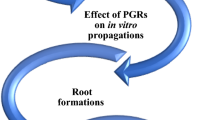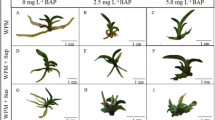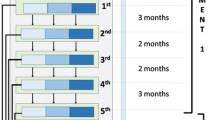Abstract
The Cerrado biodiversity has been threatened by uncontrolled anthropization, which makes essential the propagation of native species for conservation purposes. This study aims to propagate Justicia lanstyakii, a Ni-accumulating subshrub, by cuttings, micropropagation, and plantlet formation. Hence, J. lanstyakii plants were collected in September (dry season) and December (rainy season). For cuttings, stem segments treated with IBA were inoculated in either sand or vermiculite. For in vitro propagation, the explants from mature plants were decontaminated with Carbendazim, ethanol, and either Na- or Ca-hypochlorite. Explant multiplication was accomplished in two consecutive subcultures in MS medium with BAP (0.0, 0.01 and 0.1 mg.L−1). Rooting was done with explants treated with IBA (0.0 and 0.01 mg.L−1) in MS. For J. lanstyakii plantlet formation, stem segments from seven distinct matrices were inoculated in ¼MS with BAP (1 and 2 mg.L−1). The results showed that the cuttings collected in December responded significantly better than those from September. Rooting and sprouting rates of December cuttings were 98.6% and produced 5.8 and 2.5 roots/shoots per explant, respectively. Furthermore, phytoregulators and substrates had no effects on cuttings. For in vitro propagation, Ca-hypochlorite showed higher explant decontamination and survival rates. Also, phytoregulators had no significant effects on multiplication and rooting. Nonetheless, the subcultures positively affected multiplication and rooting. However, plantlet development was highly influenced by the plant matrix and BAP (1 and 2 mg.L−1). Thus, all three techniques are suitable to propagate J. lanstyakii, which will facilitate its use in bioremediation programs of Ni-contaminated areas.





Similar content being viewed by others
Data Availability
Not applicable.
Code availability
Not applicable.
References
Agritempo (2012) Sistema de monitoramento agrometeorológico. http://www.agritempo.gov.br/agroclima/sumario?uf=DF. Accessed 16 July 2012
Aihemaiti A, Jiang J, Li DA, Liu N, Yang M, Meng Y, Zou Q (2018) The interactions of metal concentrations and soil properties on toxic metal accumulation of native plants in vanadium mining area. J Environ Manage 222:216–226. https://doi.org/10.1016/j.jenvman.2018.05.081
Aina OO, Quesenberry KH, Gallo M (2015) Culture vessel and auxin treatments affect in vitro rooting and ex vitro survival of six Arachis paraguariensis genotypes. Sci Horticult 183:167–171. https://doi.org/10.1016/j.scienta.2014.12.006
Alves CCF, Oliveira JD, Estevam EBB, Xavier MN, Nicolella HD, Furtado RA et al (2019) Antiproliferative activity of essential oils from three plants of the Brazilian Cerrado: Campomanesia adamantium (Myrtaceae), Protium ovatum (Burseraceae) and Cardiopetalum calophyllum (Annonaceae). Braz J Biol 80:290–294. https://doi.org/10.1590/1519-6984.192643
Amoo SO, Finnie JF, Van Staden J (2011) The role of meta-topolins in alleviating micropropagation problems. Plant Growth Regul 63:197–206. https://doi.org/10.1007/s10725-010-9504-7
Alexandre RS, Costa PR, Chagas K, Mayrinck LG, Giles JAD, Schmildt ER (2016) Different propagules and auxin concentration on rooting of passionflower sandbank. Rev Ceres 63:691–697. https://doi.org/10.1590/0034-737X201663050014
Biondo R, Soares AM, Bertoni BW, França SC, Pereira AMS (2004) Direct organogenesis of Mandevilla illustris (Vell) Woodson and effects of its aqueous extract on the enzymatic and toxic activities of Crotalus durissus terrificus snake venom. Plant Cell Rep 22:549–552. https://doi.org/10.1007/s00299-003-0722-6
Bortolotto IM, Hiane PA, Ishii IH, de Souza PR, Campos RP, Gomes RJB et al (2017) A knowledge network to promote the use and valorization of wild food plants in the Pantanal and Cerrado, Brazil. Reg Environ Change 17:1329–1341. https://doi.org/10.1007/s10113-016-1088-y
Brandão RJA, Castilho CJM, Moraes HA (2017) Modern agriculture in the Cerrado biome: continuing the disrespect of nature. J Hyperspec Rem Sens 7:134–149. https://doi.org/10.29150/jhrs.v7.3.p134-149
Butt SJ, Varis S, Nasir IA, Sheraz S, Shahid A (2015) Micropropagation in advanced vegetable production: A review. Adv Life Sci 2:48–57
Chaiwanon J, Wang W, Zhu JY, Oh E, Wang ZY (2016) Information integration and communication in plant growth regulation. Cell 164:1257–1268. https://doi.org/10.1016/j.cell.2016.01.044
Cheng H, Chen DT, Tam NFY, Chen GZ, Li SY, Ye ZH (2012) Interactions among Fe2+, S2–, and Zn2+ tolerance, root anatomy, and radial oxygen loss in mangrove plants. J Exp Bot 63:2619–2630. https://doi.org/10.1093/jxb/err440
Chieng LMN, Chen TY, Sim, SL, Goh DKS (2014) Induction of organogenesis and somatic embryogenesis of Gonystylus bancanus (Miq.) Kurz (Ramin) In Sarawak. Kuching Sarawak For Corpor ITTO. 1:1–28
Costa DM (2011) Archaeo-environmental study of the Almas River: mining pollution and the Cerrado biome in the end of the Nineteenth Century in Mid-Western. Braz J Archaeol Sci 38:3497e3504. https://doi.org/10.1016/j.jas.2011.08.012
Costa Junior EDS, Barbosa MSDM, Silva CMAD, Silva RCSD, Kiill LHP, Beckmann-Cavalcante MZ (2018) Vegetative propagation of Rhaphiodon echinus Schauer (Lamiaceae): effects of the period of cutting in rooting, cuttings arrangement and IBA concentrations for seedlings production. Ornam Hortic 24:238–247. https://doi.org/10.14295/oh.v24i3.1232
Crouzeilles R, Curran M, Ferreira MS, Lindenmayer DB, Grelle CE, Benayas JMR (2016) A global meta-analysis on the ecological drivers of forest restoration success. Nat Commun 7:11666. https://doi.org/10.1038/ncomms11666
Paiva JGA, Fank-de-Carvalho SM, Magalhães MP, Graciano-Ribeiro D (2006) Verniz vitral incolor 500®: uma alternativa de meio de montagem economicamente viável. Acta Bot Bras 20:257–264
Dewir YH, Naidoo Y, da Silva JAT (2018) Thidiazuron-induced abnormalities in plant tissue cultures. Plant Cell Rep 37:1451–1470. https://doi.org/10.1007/s00299-018-2326-1
Dibax R, Quisen RC, Bona C, Quoirin M (2010) Plant Regeneration from cotyledonary explants of Eucalyptus camaldulensis Dehn and histological study of organogenesis in vitro. Braz Arch Biol Tech 53:311–318. https://doi.org/10.1590/S1516-89132010000200009
Đorđević B, Krajňáková J, Hampel D, Gömöry D, Havel L (2017) Effects of cadmium and lead stress on somatic embryogenesis of coniferous species. Part I: Evaluation of the genotype-dependent response. Acta Physiol Plant 39:140. https://doi.org/10.1007/s11738-017-2436-3
Evans DM, Zipper CE, Burger JA, Strahm BD, Villamagna AM (2013) Reforestation practice for enhancement of ecosystem services on a compacted surface mine: path toward ecosystem recovery. Ecol Eng 51:16–23. https://doi.org/10.1016/j.ecoleng.2012.12.065
Ferreira MC, Walter BM, Vieira DL (2015) Topsoil translocation for Brazilian savanna restoration: propagation of herbs, shrubs, and trees. Restor Ecol 23:723–728. https://doi.org/10.1111/rec.12252
Figueiredo MA, Diniz AP, Messias MCTB, Kozovits AR (2018) Propagation and establishment of rupestrian grassland grasses for restoration of degraded areas by mining. Braz J Bot 41:287–295. https://doi.org/10.1007/s40415-018-0456-x
Fortes AM, Santos F, Pais MS (2010) Organogenic nodule formation in hop: a tool to study morphogenesis in plants with biotechnological and medicinal applications. J Biomed Biotech ID 583691. https://doi.org/10.1155/2010/583691
Fortes AM, Costa J, Santos F, Seguí-Simarro JM, Palme K, Altabella T, Tiburcio AF, Pais MS (2011) Arginine decarboxylase expression, polyamines biosynthesis and reactive oxygen species during organogenic nodule formation in hop. Plant Signal Behav 6:258–269. https://doi.org/10.4161/psb.6.2.14503
Franklin G, Ignacirnuthu S (1999) Regeneration of pea (Pisum sativum L.) from seedling explants via organogenic nodule-like structures. I J Exp Biol 37:1109–1112
Francoso RD, Brandão R, Nogueira CC, Salmona YB, Machado RB, Colli GR (2015) Habitat loss and the effectiveness of protected areas in the Cerrado biodiversity hotspot. Nat Conserv 13:35–40. https://doi.org/10.1016/j.ncon.2015.04.001
Gastauer M, Silva JR, Junior CFC, Ramos SJ, Souza Filho PWM, Neto AEF, Siqueira JO (2018) Mine land rehabilitation: Modern ecological approaches for more sustainable mining. J Clean Prod 172:1409–1422. https://doi.org/10.1016/j.jclepro.2017.10.223
Giladi I, Segoli M, Ungar ED (2013) Shrubs and herbaceous seed flow in a semi-arid landscape: dual functioning of shrubs as trap and barrier. J Ecol 101:97–106. https://doi.org/10.1111/1365-2745.12019
Gomes HT, Bartos PMC, Andrade MTD, Almeida RF, Lacerda LFD, Scherwinski-Pereira JE (2017) In vitro conservation of blackberry genotypes under minimal growth conditions and subsequent large-scale micropropagation. Pesq Agropec Bras 52:1286–1290. https://doi.org/10.1590/s0100-204x2017001200018
Gomes HT, Bartos PMC, Martins AE, Oliveira SOD, Scherwinski-Pereira JE (2015) Assessment of mint (Mentha spp.) species for large-scale production of plantlets by micropropagation. Acta Sci Biol Sci 37:405–410. https://doi.org/10.4025/actascibiolsci.v37i4.26984
Halim MA, Alam MF, Rahman MH, Hossain MB, Uddin MB (2016) Sterilization process for in vitro regeneration of Stevia (Stevia rebundiana Bertoni). Int J Bus Soc Sci Res 4:320–323
Heede VD, Lecourt M (1998) L’art de bouturer et de multiplier les plantes horticoles. La Maison Rustique, Paris
Izhaki A, Yitzhak Y, Blau T, David I, Rotbaum A, Riov J, Zilkah S (2018) Rooting of cuttings of selected Diospyros virginiana clonal rootstocks and bud growth in rooted cuttings. Sci Hortic 232:13–21. https://doi.org/10.1016/j.scienta.2017.12.051
Jiménez VM (2005) Involvement of plant hormones and plant growth regulators on in vitro somatic embryogenesis. Plant Growth Regul 47:91–110
Johansen DA (1940) Plant microtechnique. McGraw-Hill Book Company, London, UK
José DP, de Campos JMS, Viccini LF, Alkimim ER, de Oliveira Santos M (2019) Micropropagation and ploidy stability of Lippia lacunosa Mart. & Schauer: an endangered Brazilian medicinal plant. J Neotrop Agric 6: 1–7. https://doi.org/10.32404/rean.v6i1.3203
Kibbler H, Johnston ME, Williams RR (2004) Adventitious root formation in cuttings of Backhousia citriodora F. Muell: 2. Seasonal influences of temperature, rainfall, flowering and auxins on the stock plant. Sci Hort 102:343–358. https://doi.org/10.1016/j.scienta.2004.02.007
Kiel CA, Daniel TF, McDade LA (2018) Phylogenetics of New World ‘justicioids’ (Justicieae: Acanthaceae): major lineages, morphological patterns, and widespread incongruence with classification. Syst Bot 43:459–484. https://doi.org/10.1600/036364418X697201
Köppen W (1900) Versuch einer Klassifikation der Klimate, vorzugsweise nach ihren Beziehungen zur Pflanzenwelt. Geogr Z 6:593–611
Korasick DA, Enders TA, Strader LC (2013) Auxin biosynthesis and storage forms. J Exp Bot 64:2541–2555. https://doi.org/10.1093/jxb/ert080
Kučera T, Horáková H, Šonská A (2008) Toxic metal ions in photoautotrophic organisms. Photosynthetica 46:481–489. https://doi.org/10.1007/s11099-008-0083-z
Kumar R, Khurana A, Sharma AK (2014) Role of plant hormones and their interplay in development and ripening of fleshy fruits. J Exp Bot 65:4561–4575. https://doi.org/10.1093/jxb/eru277
Li S, Yang B, Wu D (2008) Community succession analysis of naturally colonized plants on coal gob piles in Shanxi mining areas, China. Water Air Soil Pollut 193:211–228. https://doi.org/10.1007/s11270-008-9684-1
Liang H, Xiong Y, Guo B, Yan H, Jian S, Ren H, Zhang X, Li Y, Zeng S, Wu K, Zheng F, Silva JAT, Xiong Y, Ma G (2020) Shoot organogenesis and somatic embryogenesis from leaf and root explants of Scaevola sericea. Scient Rep 10:11343. https://doi.org/10.1038/s41598-020-68084-1
Lima DV, Batalha MA (2011) Vegetation structure: fine scale relationships with soil in a Cerrado site. Flora 206:341–346. https://doi.org/10.1016/j.flora.2010.11.003
Lima MR, Pereira LA, Silveira CE (2015) In vitro multiplication from seeds and adult explants of two ornamental Ruellia (Acanthaceae) species of Brazilian savanna (Cerrado). Phyton 55:233–249. https://doi.org/10.12905/0380.phyton55(2)2015-0233
Lin W, Wu K, Lao Z, Hu W, Lin B, Li Y, Fan H, Hu J (2019) Assessment of trace metal contamination and ecological risk in the forest ecosystem of dexing mining area in northeast Jiangxi Province, China. Ecotoxicol Environ Saf 167:76–82. https://doi.org/10.1016/j.ecoenv.2018.10.001
Ling WX, Zhong Z (2012) Seasonal variation in rooting of the cuttings from tetraploid locust in relation to nutrients and endogenous plant hormones of the shoot. Turk J Agric for 36:257–266. https://doi.org/10.3906/tar-1011-1511
Llewellyn DW, Shaffer GP (1993) Marsh restoration in the presence of intense herbivory: the role of Justicia lanceolata (Chapm.) Small. Wetlands 13:176–184. https://doi.org/10.1007/BF03160878
Lodama KE, du Toit ES, Steyn JM, Araya HT, Prinsloo G, Du Plooy CP, Robbertse PJ (2016) Improving rooting of Lobostemon fruticosus L. cuttings with delayed auxin treatment. S Afr J Bot 105:111–115. https://doi.org/10.1016/j.sajb.2016.01.005
Machado IF, Figueirôa SFDM (2001) 500 years of mining in Brazil: a brief review. Resour Policy 27:9–24. https://doi.org/10.1016/S0301-4207(01)00004-6
Mahar A, Wang P, Ali A, Awasthi MK, Lahori AH, Wang Q, Li R, Zhang Z (2016) Challenges and opportunities in the phytoremediation of heavy metals contaminated soils: a review. Ecotoxicol Environ Saf 126:111–121. https://doi.org/10.1016/j.ecoenv.2015.12.023
Maracahipes-Santos L, Lenza E, Santos JO, Mews HA, Oliveira B (2017) Effects of soil and space on the woody species composition and vegetation structure of three Cerrado phytophysiognomies in the Cerrado-Amazon transition. Braz J Biol 77:830–839. https://doi.org/10.1590/1519-6984.02016
Martins LM, Pereira AMS, França SC, Bertoni WB (2011) Micropropagação e conservação de Macrosyphonia velame (St. Hil.) Muell. Arg. em banco de germoplasma in vitro. Cienc Rural 41:454–458. https://doi.org/10.1590/S0103-84782011005000015
McCown B, Zeldin E, Pinkalla H, Dedolph R (1998) Nodule culture: a developmental pathway with high potential for regeneration, automated micropropagation, and plant metabolite production from woody plants. In: Hanover J, Keathley D (eds) Genetic Manipulation of Woody Plants. Plenum, New York, USA, pp 149–166
Mohammed A, Chiruvella KK, Ghanta RG (2016) In vitro plant regeneration, flowering, and fruiting from nodal explants of Andrographis lineata nees (Acanthaceae). J Crop Sci Biotechnol 19:195–202. https://doi.org/10.1007/s12892-016-0003-x
Murashige T, Skoog F (1962) A revised medium for rapid growth and bioassays with tobacco tissue cultures. Physiol Plant 15:473–497. https://doi.org/10.1111/j.1399-3054.1962.tb08052.x
Myers N, Mittermeier R, Mittermeier C, Fonseca GAB, Kent J (2000) Biodiversity hotspots for conservation priorities. Nature 403:853–858. https://doi.org/10.1038/35002501
O’Brien T, Feder N, McCully ME (1964) Polychromatic staining of plant cell walls by toluidine blue O. Protoplasma 59:368–373. https://doi.org/10.1007/BF01248568
Omachi CY, Siani SM, Chagas FM, Mascagni ML, Cordeiro M, Garcia GD, Thompson CC, Siegle E, Thompson FL (2018) Atlantic Forest loss caused by the world´s largest tailing dam collapse (Fundão Dam, Mariana, Brazil). RSASE 12:30–34. https://doi.org/10.1016/j.rsase.2018.08.003
Pereira LF, de Barros Cruz G, Guimarães RMF (2019) Impactos do rompimento da barragem de rejeitos de Brumadinho, Brasil: uma análise baseada nas mudanças de cobertura da terra. JEAP 4:122–129. https://doi.org/10.24221/JEAP.4.2.2019.2373.122-129
Pires MO (2020) “Cerrado”, old and new agricultural frontier. Braz Polit Sci Rev 14(e0004):1–24. https://doi.org/10.1590/1981-3821202000030006
Raji S, Ayyanar M, Ponmanickam P, Rajagopal T (2014) In vitro morphogenesis and RAPD analysis of Justicia tranquebariensis L.f.-an important medicinal plant. J Mol Biol 22:152–163
Ratié G, Quantin C, de Freitas AM, Echevarria G, Ponzevera E, Garnier J (2019) The behavior of nickel isotopes at the biogeochemical interface between ultramafic soils and Ni accumulator species. Geochem Explor 196:182–191. https://doi.org/10.1016/j.gexplo.2018.10.008
Rodrigues LA, Paiva Neto VBD, Boaretto AG, Oliveira JFD, Torrezan MDA, Lima SFD, Otoni WC (2015) In vitro propagation of Cyrtopodium saintlegerianum rchb. f. (Orchidaceae), a native orchid of the Brazilian savannah. Crop Breed Appl Biotechnol 15:10–17. https://doi.org/10.1590/1984-70332015v15n1a2
Sartin RD, de Castro Peixoto J, Lopes DB, de Paula JR (2014) Flora do bioma Cerrado: Abordagem de estudos da família Acanthaceae Juss – Espécies Ornamentais no Brasil. Fronteiras 3:164–179. https://doi.org/10.21664/2238-8869.2014v3i2.p164-179
Saviour MN (2012) Environmental impact of soil and sand mining: a review. Int J Sci Environ Tech 1:125–134
Silva LC, Paiva R, Vargas DP, Silva DPCD, Barbosa S, Herrera RC (2015) Decontaminant solution on in vitro growth of Byrsonima intermedia seedlings. Cienc Rural 45:674–679. https://doi.org/10.1590/0103-8478cr20120078
Silveria et al (2008) Sobrevivência e crescimento de seis espécies arbóreas submetidas a quatro tratamentos em área minerada no cerrado. Rev Árvore 32:731–470. https://doi.org/10.1590/S0100-67622008000400015
Silveira CES, Fukuda WS, Palhares D, Cury NF, Pereira LAR (2018) A micropropagation protocol for the domestication of Jacaranda ulei (Bignoniaceae). Phyton 58:165–174. https://doi.org/10.12905/0380.phyton58(2)-2018-0165
Singh M, Pandey A (2019) In vitro propagation of Bergenia ciliata Sternb: A valuable medicinal and ornamental plant of Sikkim Himalaya. Med Plants 11:191–194. https://doi.org/10.5958/0975-6892.2019.00024.8
Skoog F, Miller CO (1957) Chemical regulation of growth and organ formation in plant tissues cultured in vitro. Symp Soc Exp Biol 54:118–130
Solís CA, Jiménez V, Arias J (2015) Propagación asexual de azul de mata (Justicia tinctoria (Oerst.) DN Gibson, Fam. Acanthaceae) por medio de estacas. Agron Costarricense 39:91–103
Souza MC, Franco AC, Haridasan M, Rossatto DR, Araújo JF, Morellato LP, Habermann G (2015) The length of the dry season may be associated with leaf scleromorphism in Cerrado plants. Ann Braz Acad Sci 87:1691–1699. https://doi.org/10.1590/0001-376520150381
Starr CR, Corrêa RS, de Sousa FT, Hay JDV, dos Santos PF (2013) Plant colonization in a gravel mine revegetated with Stylosanthes spp. in a Neotropical savanna. Land Ecol Eng 9:189–201. https://doi.org/10.1007/s11355-012-0196-1
Swarts A, Matsiliza-Mlathi B, Kleynhans R (2018) Rooting and survival of Lobostemon fruticosus (L) H. Buek stem cuttings as affected by season, media and cutting position. S Afr J Bot 119:80–85. https://doi.org/10.1016/j.sajb.2018.08.019
Teixeira AMC, Pinto JRR, Amaral AG, Munhoz CBR (2016) Angiosperm species of “Cerrado” sensu stricto in Terra Ronca State Park, Brazil: floristics, phytogeography, and conservation. Braz J Bot 40:225–234. https://doi.org/10.1007/s40415-016-0341-4
Thakur S, Singh L, Ab Wahid Z, Siddiqui MF, Atnaw SM, Din MFM (2016) Plant-driven removal of heavy metals from soil: uptake, translocation, tolerance mechanism, challenges, and future perspectives. Environ Monit Assess 188:206. https://doi.org/10.1007/s10661-016-5211-9
Vieira LM, Kruchelski S, Gomes EN, Zuffellato-Ribas KC (2018) Indolebutyric acid on boxwood propagation by stem cuttings. Ornam Hort 24:347–352. https://doi.org/10.14295/oh.v24i4.1185
Vujović T, Ružić DJ, Cerović R (2012) In vitro shoot multiplication as influenced by repeated subculturing of shoots of contemporary fruit rootstocks. Hort Sci 39:101–107
Wada KC, Takeno K (2010) Stress-Induced Flowering Plant Signal Behav 5:944–947. https://doi.org/10.4161/psb.5.8.11826
Zaidan LBP, Felippe GM (1994) Flowering of Cerrado plants: experiments in semicontrolled environmental conditions. FNL 18:4–11
Zappi DC, Filardi FLR, Leitman P, Souza VC, Walter BM, Pirani JR, Morim MP, Queiroz LP, Cavalcanti TB, Mansano VF, Forzza RC (2015) Growing knowledge: an overview of seed plant diversity in Brazil. Rodriguésia 66:1085–1113. https://doi.org/10.1590/2175-7860201566411
Zlatev Z, Lidon FC (2012) An overview on drought induced changes in plant growth, water relations and photosynthesis. Emir J Food Agric 24:57–72. https://doi.org/10.9755/ejfa.v24i1.10599
Funding
This study was funded by Coordination of Improvement of Higher Education Personnel (CAPES), Federal District Research Support Foundation (FAPDF, grant No 0193.000941/2015), and Graduate Program in Botany of the University of Brasilia, and the Reference Centre of Nature Conservation and Recuperation of Degraded Areas of the University of Brasilia (CRAD).
Author information
Authors and Affiliations
Contributions
Mayara Rodrigues Lima and Conceição Eneida dos Santos Silveira performed and designed experiments, analyzed and interpreted data and wrote the manuscript. Hugo Teixeira Gomes helped with the designing of the experiments, analyzed, and interpreted data. Natalia Faustino Cury assisted in plantlet formation analysis. Luiz Alfredo Rodrigues Pereira helped with the anatomical analysis, corrected, and revised the manuscript.
Corresponding author
Ethics declarations
Conflicts of interest/Competing interest
On behalf of all authors, the corresponding author states that there is neither conflict of interest nor competing interest.
Additional information
Publisher's Note
Springer Nature remains neutral with regard to jurisdictional claims in published maps and institutional affiliations.
Rights and permissions
About this article
Cite this article
Lima, M.R., Gomes, H.T., Cury, N.F. et al. Developing propagation protocols for Justicia lanstyakii Rizz. (Acanthaceae), an ornamental Ni-accumulating subshrub of Brazilian Cerrado. Biologia 77, 967–980 (2022). https://doi.org/10.1007/s11756-021-00987-4
Received:
Accepted:
Published:
Issue Date:
DOI: https://doi.org/10.1007/s11756-021-00987-4




